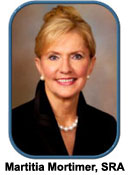|
PORT AUTHORITY
WANTS TO SELL WORLD TRADE CENTER BUILDING
The Port Authority of New York and New Jersey is
looking for a "partner" in its quest to build a new World Trade
Center complex in New York.
"As 1 World Trade Center continues to
rise into the city skyline, the timing is right to determine whether
there is a strategic partnership that can add long-term success into
the building," announced Stephen Sigmund, the Port Authority's chief
spokesman.
Late last year, the authority asked a small, exclusive group of
commercial real estate property owners and developers to place bids
for part-ownership of the project, according to New York Times
reporter Charles Bagli. When completed, probably in 2013, the
105-story building will stand 1,776 feet tall, according to the
patriotic plans. It is expected to be one of the most expensive
commercial buildings in the United States. The authority is counting
on the partner it chooses to market the project, not an easy task
considering the current recession in commercial real estate the city
is going through.
"There's a substantial amount of real estate equity capital looking
for the right investment," said Michael Rotchford, executive vice
president of Cushman & Wakefield, who is conducting the authority's
search for the right partner. "We think this is potentially one of
the best real estate investments available in New York."
HIGH 'WALK
SCORES' BOOST HOME VALUES
 A
recently published study suggests a home's value is somewhat
dependent upon how practical its neighborhood is for walking. The
study was sponsored by CEOs for Cities, a Chicago-based nonprofit,
which bills itself as "a national cross-sector network of urban
leaders from civic, business and philanthropic sectors dedicated to
building and sustaining the next A
recently published study suggests a home's value is somewhat
dependent upon how practical its neighborhood is for walking. The
study was sponsored by CEOs for Cities, a Chicago-based nonprofit,
which bills itself as "a national cross-sector network of urban
leaders from civic, business and philanthropic sectors dedicated to
building and sustaining the next
generation of great cities." It was written by Joe Cortright,
president and chief economist of Impresa, Inc., a consulting firm
out of Portland, Ore., that specializes in metropolitan economics.
"The walkability of cities translates directly into increases in
home values," Cortright wrote in the report, entitled "Walking the
Walk." "Homes located in more walkable neighborhoods, those with a
mix of common daily shopping and social destinations within a short
distance, command a price premium over otherwise similar homes in
less walkable areas."
Homes at most metropolitan addresses in the United States have their
walkability measured on the Web site Walkscore.com, with zero for an
area where residents are totally vehicle-dependent and 100 where
everything someone needs is within a short walk. The study compared
the Walk Scores with sales figures of 90,000 homes in markets
throughout the country before announcing its conclusion.
"After controlling for all other factors that are known to influence housing value, our study showed a positive correlation
between walkability and housing prices in 13 of the 15 housing
markets we studied," Cortright wrote. "In the typical market, an
additional one point increase in Walk Score was associated with
between a $500 and $3,000 increase in home values."
HOME OWNERSHIP
RATE PREDICTED TO DECLINE
A study conducted by the Federal Reserve Bank of New
York concluded with the prediction that the U.S homeownership rate
will continue to drop. In a staff report, entitled "The
Homeownership Gap," Federal Reserve economists Andrew Haughwout,
Richard Peach and Joseph Tracy noted that the homeownership rate in
this country reached an all-time high of 69% in the
third quarter of 2006 and dropped 1.7% over the next three years to
67.3%, which was the lowest it had been since the second quarter of
2000.
Increasing unemployment and foreclosures, combined with decreasing
housing prices have led to this rate decline, the report said. The
economists noted the higher percentage of negative-equity
households, where more is owed on the mortgage than the home is
worth, and said this trend will lead to less "household
mobility," due
to the fact that people in this situation "need to delay a move
during the period they are rebuilding their savings." They site
Census reports to point out that "the number of households moving is
at its lowest point since 1962."
"The current severe house price cycle, combined with borrowers who
had little or no equity at origination of their mortgages, has led
to a dramatic rise in homeowners with negative equity," the report
said in its conclusion. "This situation is likely to put downward
pressure on future homeownership rates, and has potentially
important implications for the maintenance of the
housing stock, the stability of neighborhoods, and future household
saving behavior."
OVERVALUED
MARKETS STUDY A REVERSAL OF FOUR YEARS AGO
Unlike its study four years ago, when it concluded
most homes in the United States were undervalued, CNNMoney.com found
the reverse to be true in its recently released report on overvalued
and undervalued housing markets late last month. The study looked at
330 markets (metropolitan areas) in the United States and concluded
that 242 of them are undervalued because it considered their homes
to be priced less than fair market value. Only 87 markets were
overvalued, according to the study.
In January 2006, CNNMoney.com's ranking of U.S. housing markets
indicated that out of 299 markets studied, 213 were overpriced.
Needless to say, a burst in the bubbled housing market has occurred
since then.
Today, the two best-known cities for gambling in the United States
are at opposite ends of the 330-market study. Atlantic City, N.J.,
is considered by the CNNMoney to be the most overvalued market (at
30.2% over fair market value), while Las Vegas (at 41.4% below fair
market value) is considered to be the most undervalued. Following
Atlantic City in the overpriced category are Wenachee, Wash. (28.9%)
and Ocean City, N.J. (26.6%) Following Vegas in the bargain market
territory are Vero Beach, Fla, (- 39.8%), Merced, Calif. (-37.7%)
and Cape Coral, Fla. (-36.8%).
Les Christie, staff writer at CNNMoney, said that the ratings came
from a combination of data on "Median home prices, local interest
rates, population densities and income, plus historical premiums or
discounts that areas have exhibited over time." The statistics came
from National City Corp. and HIS Global Insight.
"I've done some research that shows when you get a bubble, you don't
get a return to normalcy," said Richard DeKaser, who engineered the
report for National City. "You go past normalcy for a long period of
undervaluation."
ASK MARTITIA
 QUESTION:
Can an appraiser use the same appraisal report to communicate
multiple, appraisal intended uses, along with a single value, and be
in compliance with USPAP? QUESTION:
Can an appraiser use the same appraisal report to communicate
multiple, appraisal intended uses, along with a single value, and be
in compliance with USPAP?
MARTITIA: Yes, as long as the intended uses are performed with
the same scope of work and have the same type and definition of
value. In order to be in compliance with the Uniform Standards of
Professional Appraisal Practice, the appraiser must identify all of
the intended uses of the appraisal
opinions and designated values in the appraisal report.
Martitia Mortimer, Elliott’s executive vice president, answers
appraisal questions on a regular basis in Elliott Real Estate
News.
QUOTES
 "A
baby is born with a need to be loved, and never outgrows it."
–
Frank Howard Clark "A
baby is born with a need to be loved, and never outgrows it."
–
Frank Howard Clark
"World War II was the last government program that really worked."
–
George Will
"May your walls know joy, may every room hold laughter, and every
window open to great possibility."
–
Mary Radmacher
"Always bear in mind that your own resolution to succeed is more
important than anything else."
–
Abraham Lincoln
"It's the most unhappy people who most fear change."
–
Mignon McLaughlin

 |
| |
| Newsletter Editor:
kevin@elliottco.com
|
| |
|
3316-A
Battleground Avenue
Greensboro, NC 27410 |
Toll
Free 800-854-5889
Fax 336-854-7734 |
| |
|
If you wish to be REMOVED from our
e-mail list
click
here. |
|









